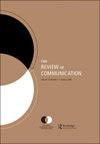Government communication strategy and its reflection on media construction of pandemic: A structured analysis of COVID-19 in India
Q3 Social Sciences
引用次数: 1
Abstract
ABSTRACT The COVID-19 outbreak led to challenges in framing communication strategy on the part of the government among various stakeholders and especially to the common people. The government communication approach should focus on the meaningful participation of people in vulnerable conditions to achieve the best-possible result. The study examines various factors concerning the inclusivity in communication approaches adopted by the government and subsequent media coverage in India during this crisis. The complete nationwide lockdown tenure is selected for the study to recognize the communication strategy of the government and media in the initial phase of the COVID-19 pandemic in India. Two mainstream Indian dailies—The Hindu & The Times of India—have been assessed to analyze the media construction of the pandemic, and 42 websites of central government ministries are also analyzed to frame the nature of governmental communication policy. The study reveals that governmental communication strategies were mainly instructional and confined to the macro level rather than the micro level. During this period, media narratives were mostly associated with governmental initiatives of crisis management. It established government as a powerful social actor while diminishing the voice of other concerned stakeholders in crisis management.政府传播策略及其对疫情媒体建设的思考——对印度新冠肺炎疫情的结构性分析
2019冠状病毒病(COVID-19)疫情导致政府在制定与各利益相关者,特别是与普通民众的沟通策略方面面临挑战。政府的沟通方式应侧重于弱势群体的有意义参与,以取得尽可能好的结果。该研究考察了在这次危机期间,印度政府和随后的媒体报道所采用的沟通方法的包容性的各种因素。选择全国范围内的完全封锁期作为研究对象,是为了表彰印度政府和媒体在新冠肺炎大流行初期的传播策略。对印度主流报纸《印度教徒报》和《印度时报》进行了评价,分析了新冠疫情的媒体建设情况,对42个中央政府部门网站进行了分析,分析了政府传播政策的性质。研究表明,政府传播策略主要是指导性的,局限于宏观层面而非微观层面。在此期间,媒体的叙述大多与政府的危机管理举措有关。它确立了政府作为一个强大的社会行动者的地位,同时削弱了其他有关利益相关者在危机管理中的发言权。
本文章由计算机程序翻译,如有差异,请以英文原文为准。
求助全文
约1分钟内获得全文
求助全文

 求助内容:
求助内容: 应助结果提醒方式:
应助结果提醒方式:


